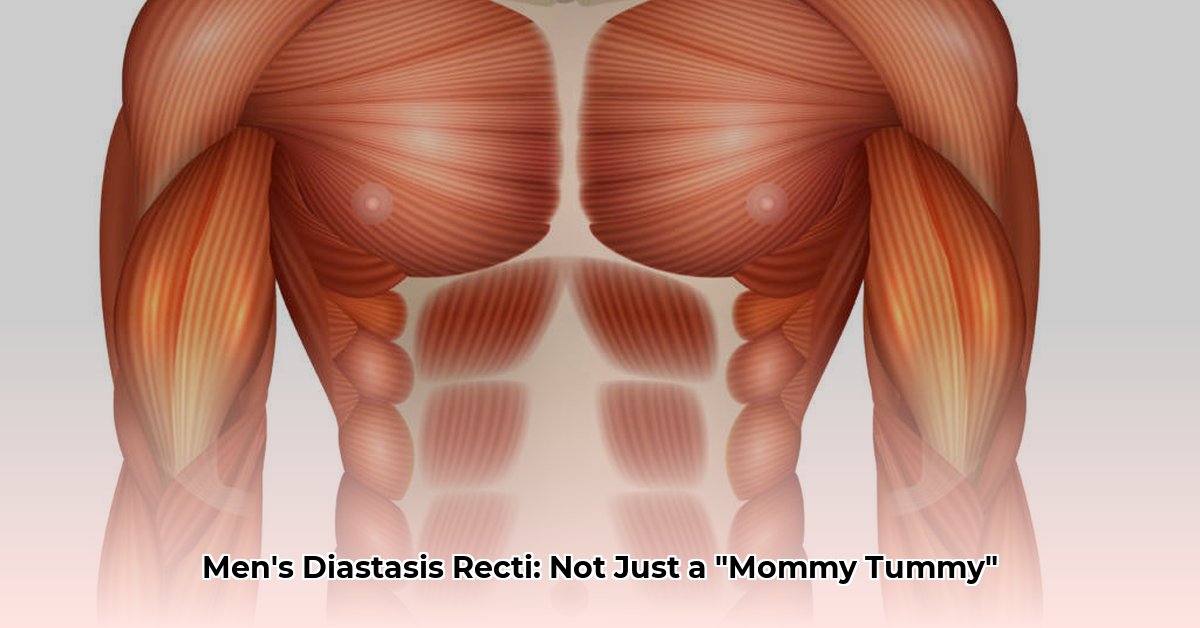Understanding Abdominal Separation
Do you have a persistent bulge in your belly that won’t go away, no matter how many crunches you do? It might be diastasis recti, a separation of the abdominal muscles. While common in postpartum women, men, particularly those who lift heavy weights or experience rapid weight fluctuations, can develop this condition. It’s more than just a cosmetic issue; diastasis recti can cause discomfort, weakness, and functional limitations. This guide provides a comprehensive understanding of diastasis recti in men, from causes and symptoms to diagnosis, exercises, and treatment options.
What Causes It?
Diastasis recti occurs when the connective tissue (linea alba) between the rectus abdominis muscles (your “six-pack” muscles) stretches and thins, causing the muscles to separate. Several factors may contribute to this in men:
- Improper Weightlifting: Lifting heavy weights with incorrect form, especially exercises like crunches and squats, strains the abdominal wall, potentially leading to separation.
- Rapid Weight Changes: Sudden weight gain or loss can stretch the linea alba, increasing the risk of diastasis recti. Bodybuilders are particularly susceptible due to rapid muscle growth.
- Genetic Predisposition: Some individuals may be genetically more prone to weaker connective tissue.
- Medical Conditions: Certain conditions, like cirrhosis of the liver, can increase abdominal pressure, potentially contributing to diastasis recti. An abdominal aortic aneurysm (AAA), though less common, is also sometimes associated with the condition.
- Aging: Connective tissue naturally loses elasticity with age, increasing susceptibility.
Ongoing research continues to explore the complex interplay of these factors.
Recognizing the Signs
A visible bulge or protrusion along the midline of your stomach, especially when straining, is a primary indicator. Other potential symptoms include:
- Lower back pain
- Poor posture
- Constipation
- Urinary incontinence (leakage)
- Hernia (sometimes occurs alongside diastasis recti)
Self-Check: Lie on your back with knees bent and feet flat. Gently lift your head and shoulders, engaging your abs. Feel along your midline above and below your belly button. If you can fit two or more fingers into the gap, it might indicate diastasis recti. Consult a healthcare professional for a definitive diagnosis.
Diagnosis and Treatment
A doctor or physical therapist can diagnose diastasis recti through a physical examination, similar to the self-check, but with more precise assessment. They may also use calipers or ultrasound imaging to measure the separation. Providing a complete medical history, including weightlifting habits, past surgeries, and any weight fluctuations, is crucial for accurate diagnosis.
Treatment depends on the severity of the separation and individual needs. Options include:
- Targeted Exercises: Specific exercises focusing on strengthening the deep core muscles (transverse abdominis) can help reduce the separation and improve core stability. See the next section for a detailed exercise guide.
- Tupler Technique: A specialized non-surgical program involving exercises, abdominal splinting, and education designed to re-align and strengthen the connective tissue.
- Physical Therapy: A physical therapist specializing in men’s health and pelvic floor dysfunction can create a personalized exercise program and provide expert guidance.
- Surgery: Typically reserved for severe cases with wide separation or significant functional impairment.
Effective Exercises: Step-by-Step
These exercises target the deep core muscles, crucial for improving diastasis recti. Remember to consult a healthcare professional before starting any new exercise program:
1. Diaphragmatic Breathing (Blowing Out Candles): Lie on your back, knees bent. Inhale deeply, letting your belly expand. Exhale slowly, drawing your belly button towards your spine. Repeat 10-15 times.
2. Tummy Tucks: Stand tall, relax your abs. Gently pull your belly button inwards, engaging your deep core. Hold for 5-10 seconds. Repeat 20-30 times.
3. Heel Slides: Lie on your back, knees bent. Inhale, drawing your belly button slightly inwards. Exhale, slowly slide one heel along the floor, extending your leg. Inhale, slide back. Repeat 30 times per leg.
4. Single-Leg Glute Bridge: Lie on your back, knees bent. Extend one leg. Lift your hips, engaging glutes and core. Lower slowly. Repeat 20 times per leg.
5. Marches: Lie on your back, knees bent. Engage your core. Gently lower one heel, tapping the floor lightly (if comfortable). Alternate legs. Aim for 40-50 repetitions.
6. Reverse Crunches (Advanced Marches): Similar to marches, but lower both heels simultaneously. Focus on slow, controlled movements. 15-20 repetitions.
7. Glute Bridge: Lie on your back, knees bent. Lift your hips, forming a straight line from shoulders to knees. Squeeze glutes and engage core. Lower slowly. Repeat 10-15 times.
8. Bird Dog: Start on all fours. Extend one arm forward and the opposite leg back, maintaining a neutral spine. Hold briefly. Repeat 10-15 times per side.
9. Bent Knee Fallout: Lie on your back, knees bent. Engage your core. Gently lower one knee outwards, maintaining control. Return to the starting position. Repeat 10-15 times per side.
Exercises to Avoid:
- Crunches
- Sit-ups
- Planks (until core strength improves)
- Any movements causing your belly to bulge outward
- Heavy lifting (consult a professional)
Prevention and Long-Term Management
Maintaining a healthy weight, practicing proper lifting techniques (engaging your core, avoiding jerky movements), and incorporating regular core-strengthening exercises can help prevent diastasis recti and reduce the risk of recurrence.
Finding a Professional
Consult a doctor or physical therapist specializing in men’s health and pelvic floor dysfunction for personalized guidance and treatment.
FAQ
| Question | Answer |
|---|---|
| Is it a hernia? | No, but it can be mistaken for one. A doctor can differentiate between the two. |
| Post-surgery recovery? | Follow your surgeon’s instructions carefully. Gentle movement and gradual return to activity are crucial. |
Disclaimer: This article provides general information and should not be considered medical advice. Always consult a qualified healthcare professional for any health concerns or before starting any new exercise program.
- Wellness Fair Ideas for Work to Boost Employee Wellbeing - December 15, 2025
- Affordable Employee Wellness Fair Ideas for Any Budget - December 14, 2025
- Employee Wellness Programs Strategically Benefit Employee Health And Retention - December 13, 2025
















